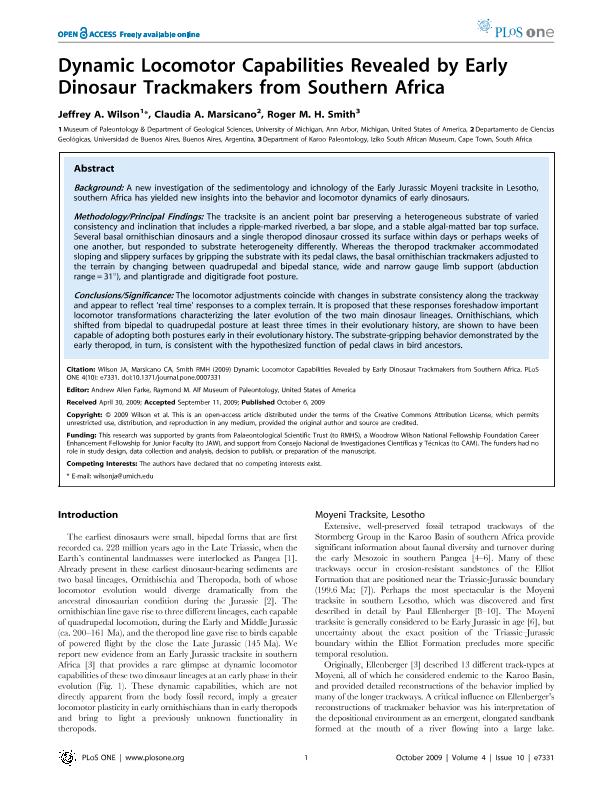Mostrar el registro sencillo del ítem
dc.contributor.author
Wilson, Jeffrey A.
dc.contributor.author
Marsicano, Claudia Alicia

dc.contributor.author
Smith, Roger M. H.

dc.date.available
2019-12-20T22:09:08Z
dc.date.issued
2009-10
dc.identifier.citation
Wilson, Jeffrey A.; Marsicano, Claudia Alicia; Smith, Roger M. H.; Dynamic locomotor capabilities revealed by early dinosaur trackmakers from Southern Africa; Public Library of Science; Plos One; 4; 10; 10-2009; 1-8; e7331
dc.identifier.issn
1932-6203
dc.identifier.uri
http://hdl.handle.net/11336/92711
dc.description.abstract
Background: A new investigation of the sedimentology and ichnology of the Early Jurassic Moyeni tracksite in Lesotho, southern Africa has yielded new insights into the behavior and locomotor dynamics of early dinosaurs. Methodology/Principal Findings: The tracksite is an ancient point bar preserving a heterogeneous substrate of varied consistency and inclination that includes a ripple-marked riverbed, a bar slope, and a stable algal-matted bar top surface. Several basal ornithischian dinosaurs and a single theropod dinosaur crossed its surface within days or perhaps weeks of one another, but responded to substrate heterogeneity differently. Whereas the theropod trackmaker accommodated sloping and slippery surfaces by gripping the substrate with its pedal claws, the basal ornithischian trackmakers adjusted to the terrain by changing between quadrupedal and bipedal stance, wide and narrow gauge limb support (abduction range = 31°), and plantigrade and digitigrade foot posture. Conclusions/Significance: The locomotor adjustments coincide with changes in substrate consistency along the trackway and appear to reflect 'real time' responses to a complex terrain. It is proposed that these responses foreshadow important locomotor transformations characterizing the later evolution of the two main dinosaur lineages. Ornithischians, which shifted from bipedal to quadrupedal posture at least three times in their evolutionary history, are shown to have been capable of adopting both postures early in their evolutionary history. The substrate-gripping behavior demonstrated by the early theropod, in turn, is consistent with the hypothesized function of pedal claws in bird ancestors.
dc.format
application/pdf
dc.language.iso
eng
dc.publisher
Public Library of Science

dc.rights
info:eu-repo/semantics/openAccess
dc.rights.uri
https://creativecommons.org/licenses/by-nc-sa/2.5/ar/
dc.subject
Dinosauria
dc.subject
Footprints
dc.subject
Palaeobiology
dc.subject
Early Jurassic Lesotho
dc.subject.classification
Paleontología

dc.subject.classification
Ciencias de la Tierra y relacionadas con el Medio Ambiente

dc.subject.classification
CIENCIAS NATURALES Y EXACTAS

dc.title
Dynamic locomotor capabilities revealed by early dinosaur trackmakers from Southern Africa
dc.type
info:eu-repo/semantics/article
dc.type
info:ar-repo/semantics/artículo
dc.type
info:eu-repo/semantics/publishedVersion
dc.date.updated
2019-10-10T19:34:28Z
dc.journal.volume
4
dc.journal.number
10
dc.journal.pagination
1-8; e7331
dc.journal.pais
Estados Unidos

dc.journal.ciudad
San Francisco
dc.description.fil
Fil: Wilson, Jeffrey A.. University of Michigan, Ann Arbor, Michigan; Argentina
dc.description.fil
Fil: Marsicano, Claudia Alicia. Consejo Nacional de Investigaciones Científicas y Técnicas. Oficina de Coordinación Administrativa Ciudad Universitaria. Instituto de Estudios Andinos "Don Pablo Groeber". Universidad de Buenos Aires. Facultad de Ciencias Exactas y Naturales. Instituto de Estudios Andinos "Don Pablo Groeber"; Argentina
dc.description.fil
Fil: Smith, Roger M. H.. ziko South African Museum, Cape Town; Sudáfrica
dc.journal.title
Plos One

dc.relation.alternativeid
info:eu-repo/semantics/altIdentifier/url/https://journals.plos.org/plosone/article?id=10.1371/journal.pone.0007331
dc.relation.alternativeid
info:eu-repo/semantics/altIdentifier/doi/http://dx.doi.org/10.1371/journal.pone.0007331
Archivos asociados
